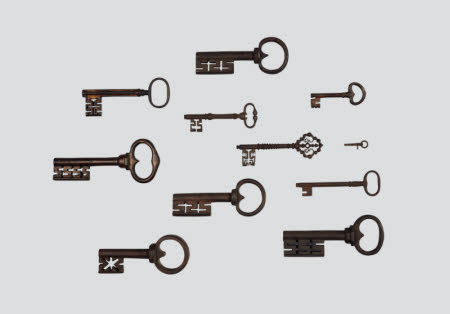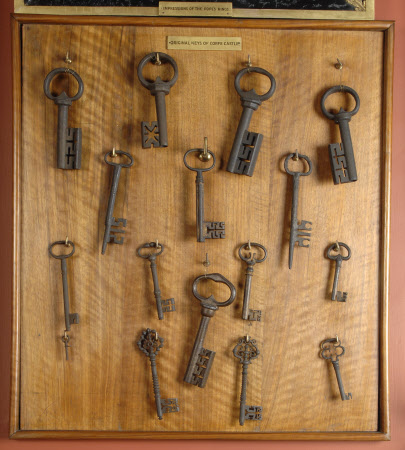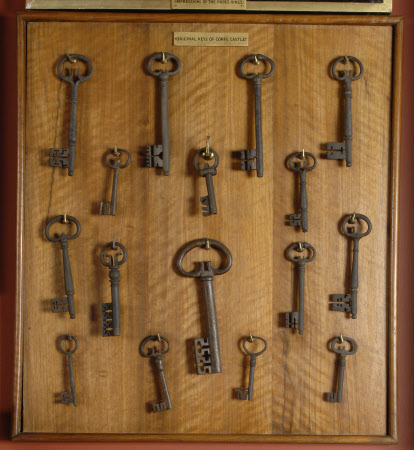15th, 16th and early 17th seventeenth century English iron and gilt keys said to be from Corfe Castle
Category
Metalwork
Date
c. 1500 - c. 1625
Materials
Wood
Order this imageCollection
Kingston Lacy Estate, Dorset
NT 1255200
Caption
According to family legend, these large metal keys at Kingston Lacy are souvenirs from an English Civil War siege. They are thought to have been given to royalist ‘Brave Dame Mary’ Bankes (c.1598–1661), who helped defend Corfe Castle from repeated attacks by Parliamentary troops. When the castle finally surrendered in February 1646, the Parliamentarian commander reportedly returned the castle keys to Lady Mary as a gesture of respect for her courage in defending her home. The castle was ‘slighted’ (deliberately damaged to deny its use to the enemy), and the rubble was reused in local buildings. Today, historians debate whether Lady Mary was even at the castle when it fell. Records do show, however, that she continued to trace and retrieve family furniture, tapestries and other castle contents that had been stripped, seized and sold. She lived to see the restoration of King Charles II and the return of her family estates. Her proud descendant William John Bankes (1786–1855) commissioned a bronze statue of Lady Mary clutching a key (see NT 1255195.2), for the Bankes’s new home at Kingston Lacy, thus capturing this important moment in the family’s history.
Summary
One panel with 15 keys and one panel with 16 keys. Early 16th or 17th century English iron keys said to be from Corfe Castle.
Full description
As a Royalist family, the Bankes' found themselves under attack during the English Civil War. When war broke out, Sir John Bankes accompanied the king to Oxford and was impeached by parliament in 1643, before dying suddenly in December 1644. Meanwhile parliamentarians occupied large areas of Dorset and Corfe Castle was besieged on two occasions. The first, unsuccessful siege of Corfe Castle in 1643 lasted for six weeks. The second siege took place in winter 1645-46 and lasted for 48 days. The parliamentarian commander, Colonel Bingham, is reported to have returned the keys of the castle to the widowed ‘Brave Dame Mary’ as a gesture of respect for her spirited defence, on the castle’s surrender. Historians still debate whether Lady Mary was resident at Corfe Castle during the second siege. Some entries in her household account books, including payments for ‘nurses and servants at buckmore’ suggests it is possible she was at Bockmer in Buckinghamshire, the home of her daughter Alice. Although it is not conclusive evidence of her absence, it is noticeable that Colonel Bingham does not mention Lady Mary, her family or the keys in his letters to Parliament in the days following the siege. Nonetheless, the eulogy on her memorial plaque in St Martin’s Church, Ruislip (written by her son, Sir Ralph Bankes), praises her ‘courage even above her sex’, while George Bankes celebrated her bravery in a history of Corfe Castle published in 1853. William John Bankes (1786–1855) commissioned some bronze sculptures of Lady Mary, Sir John and Charles I by Baron Carlo Marochetti for the new family seat at Kingston Lacy, to tell the story of his ancestors’ defence of Corfe Castle. Lady Mary holds a sword and a key (see NT 1255195.2).
Provenance
These keys were given to 'Brave Dame Mary', with (on chimney piece and on fireplace) perhaps a spur, two pistol-locks and two cannon-balls from the siege (1646).


